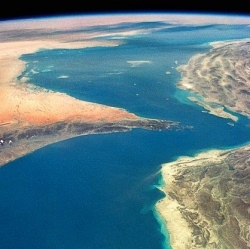
It’s been half a century since the United States finally dusted Russia in the space race, as NASA’s Gemini program ticked off an unprecedented series of long-duration flights, spacewalks, and in-space rendezvous to put America firmly on course to the Moon. Today, a new space race has begun.
This modern face-off has some key differences, not the least of which is that America’s and Russia’s space programs presently depend upon one another. Instead of Cold War-fueled international competition, the modern space race has an all-American flavor with an established company, Boeing, against an upstart, SpaceX. Both firms are developing spacecraft to fly NASA astronauts to the International Space Station, and they hope to do so before the end of 2017.
Last week some clues emerged when both companies were called to appear before a subcommittee of NASA’s Advisory Council, which possesses limited power but has access to information.
Benjamin Reed, who directs SpaceX’s commercial crew program, offered the most concrete timeline of the two competitors. Reed said his company intends to launch a test flight of its Dragon spacecraft by the end of 2016 and is targeting March 2017 for the first crewed flight of the vehicle.
Boeing Vice President John Mulholland said his company plans to conduct both its test flight and first crewed flight of the Starliner spacecraft in 2017. Previously, the company has said it would like to fly its first crewed flight by September 2017.
Advantage SpaceX, then? In reality, each company’s dates are virtually meaningless. Both firms have their own challenges to work through before reaching their respective launch pads at Kennedy Space Center in Florida.
SpaceX, while it has had some dazzling successes and has slashed launch costs, is notorious in the aerospace industry for over promising early launch dates. The company is also scrambling to recover a launch failure of its Falcon 9 rocket in June. That rocket carried a cargo variant of its Dragon spacecraft, and an upgraded Falcon 9 will also launch the crewed Dragon. To allay concerns about the Falcon 9’s reliability, Reed said the Falcon 9 will fly “dozens” of times more before humans launch on it.
Boeing, meanwhile, must adjust to a new way of doing business as it develops the Starliner spacecraft. During its half century as one of NASA’s main contractors, the company has worked on a cost-plus contracting basis, essentially meaning Boeing got paid for all of its costs related to work on a job, plus an additional payment. Such contracts do not place a premium on speed or efficiency.
The companies are now in the final phase of NASA’s commercial crew program. In September 2014, Boeing won a $4.2 billion award to provide crewed launch services, and SpaceX won $2.6 billion. (SpaceX received less because it offered to provide lower-cost flights). Both firms are now in the process of completing more than a dozen “milestones,” such as spacesuits and parachute qualification tests as well as the actual flight tests, before NASA certifies their vehicles as ready to fly.
Publicly, neither company will acknowledge the space race. But make no mistake, both companies want to win, and badly. A few years ago, Boeing and other major aerospace companies viewed SpaceX as something of a joke. Then the company started flying and winning NASA contracts, and now SpaceX presents a major threat to the old-guard aerospace titans. Additionally, there is no small measure of resentment at the company’s celebrity chief executive, Elon Musk.
Musk, of course, loves to make a splash. America for four years has relied on Russia to launch its astronauts into space. Last year Russia’s chief space minister, Dmitry Rogozin, taunted NASA by saying it could use a trampoline to launch its astronauts into space if Washington DC didn’t like what his country was doing in Ukraine. Now in less than two years, Musk has a chance to have his spacecraft, with the SpaceX logo right next to the American flag, reclaim America’s spaceflight heritage.
